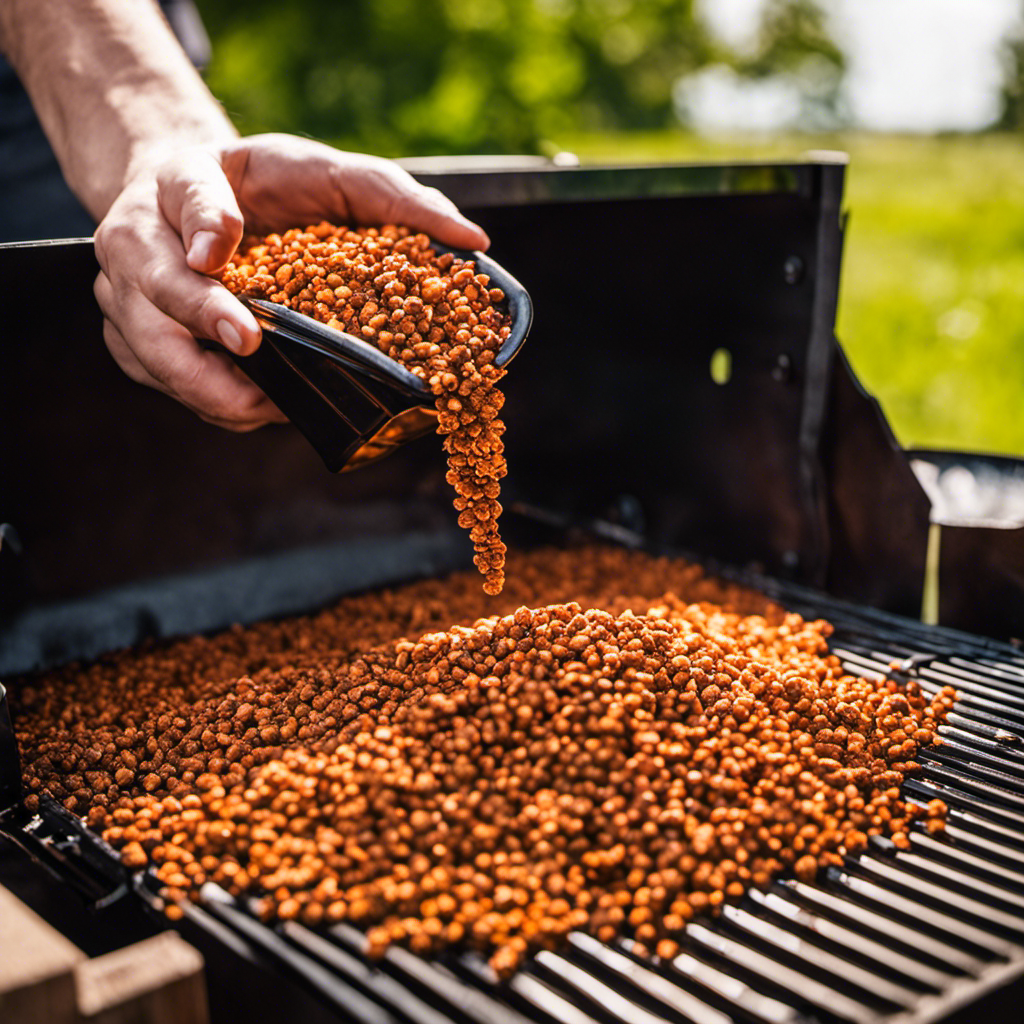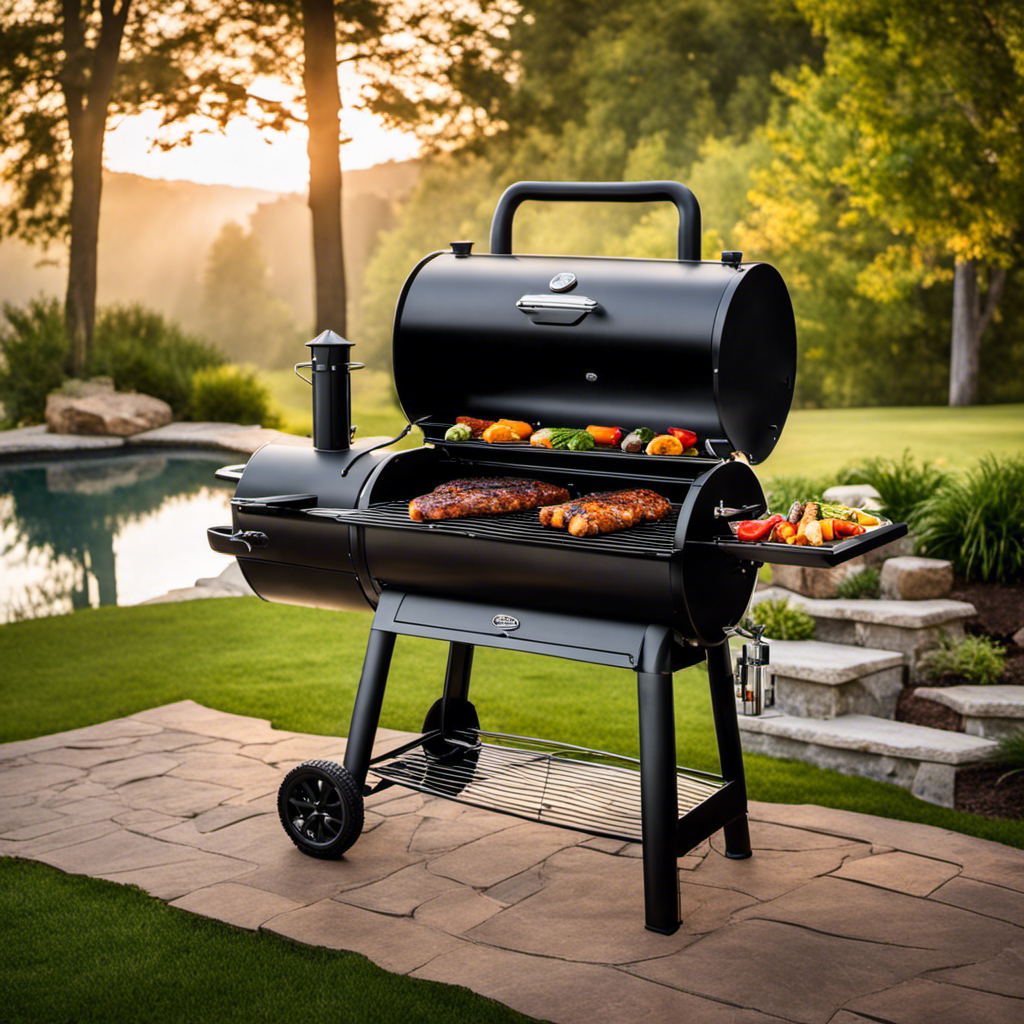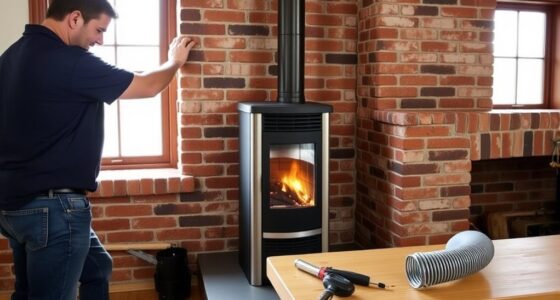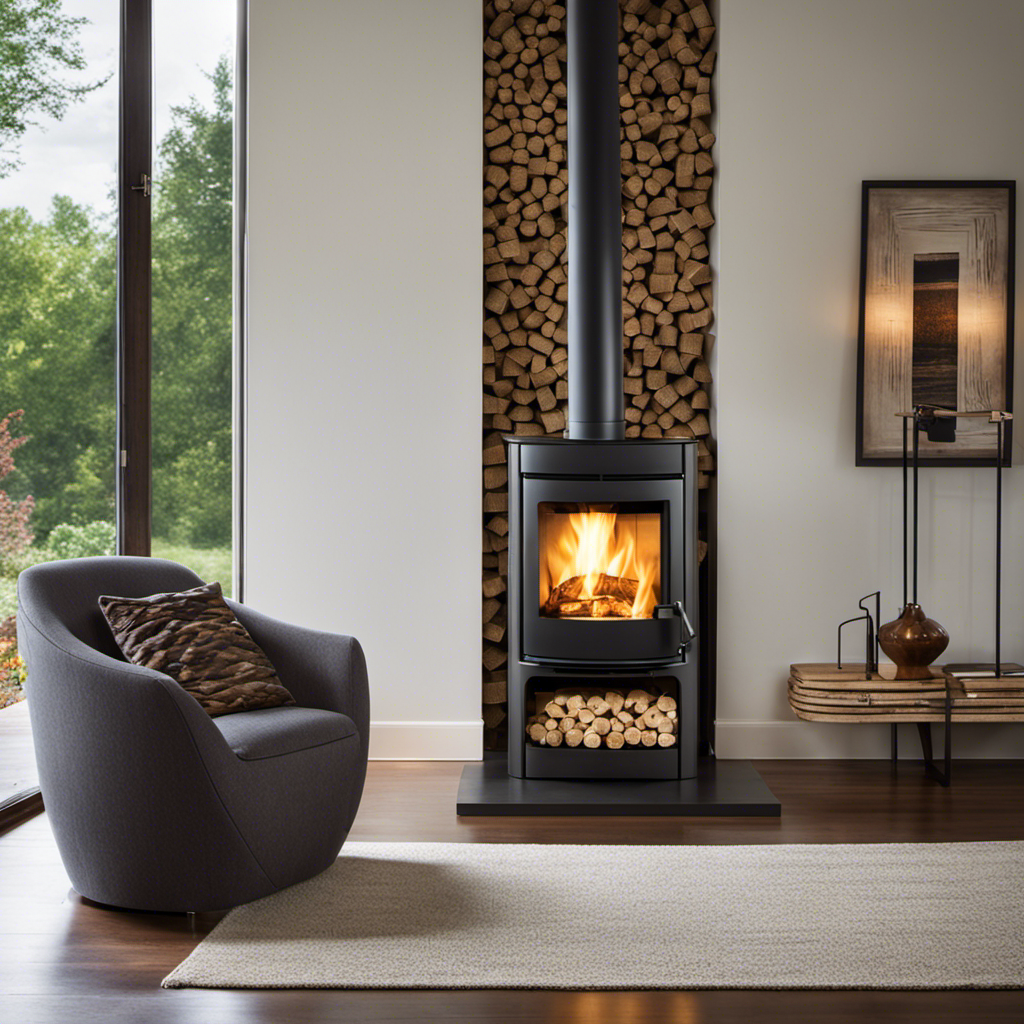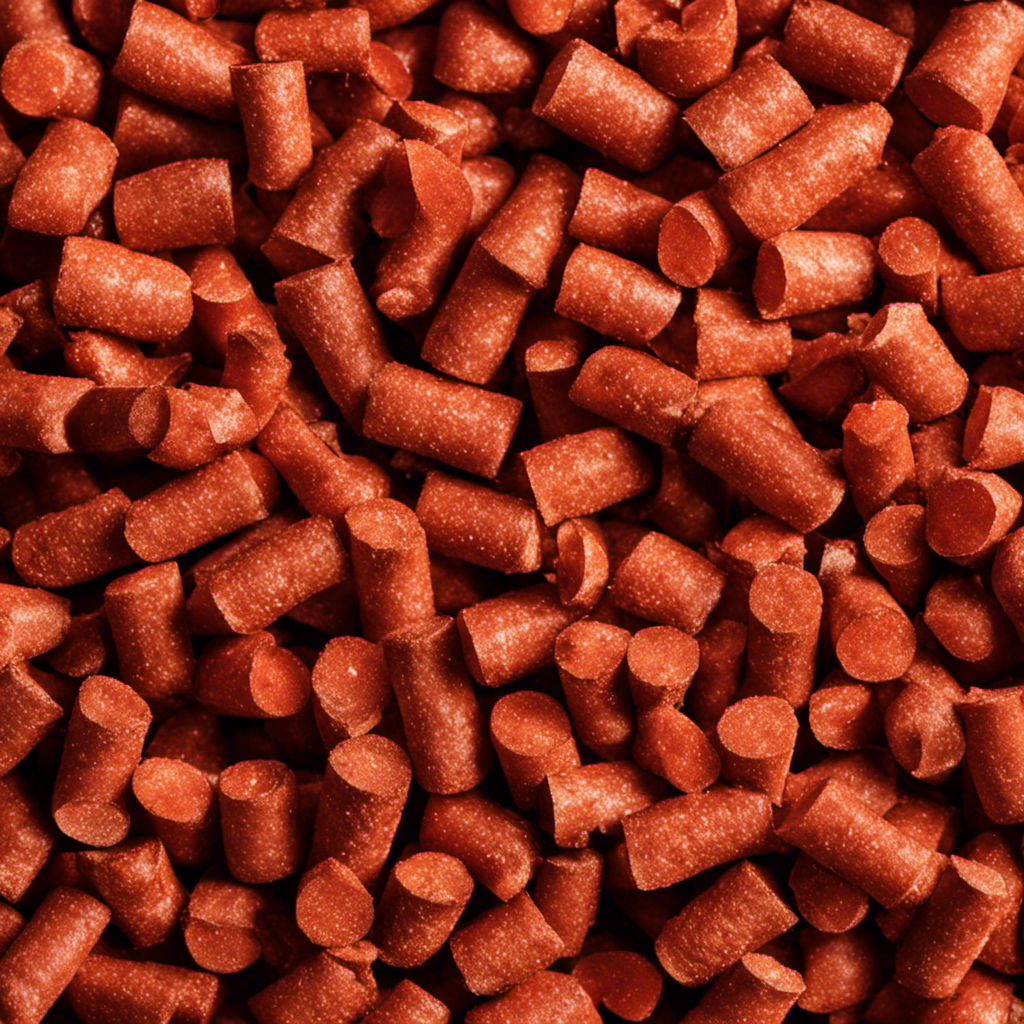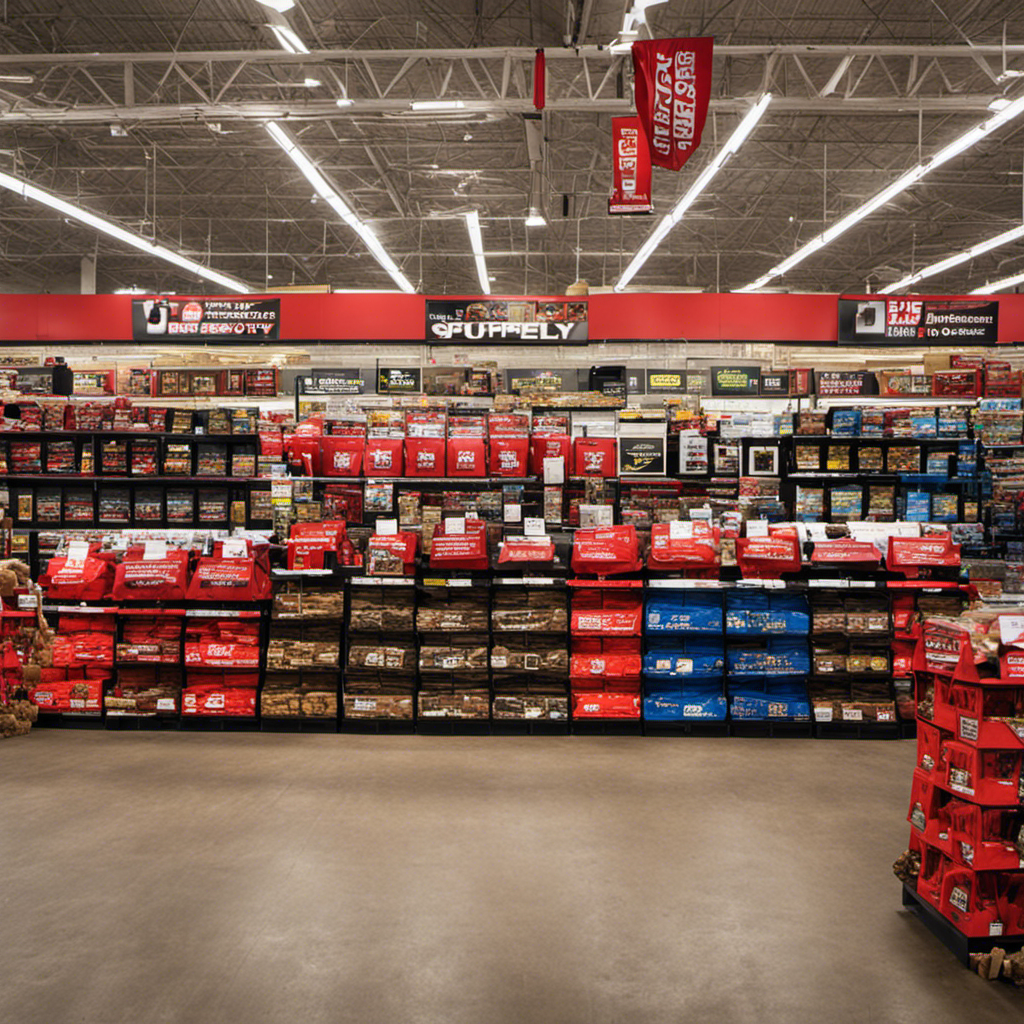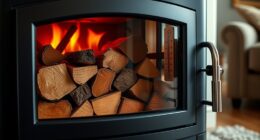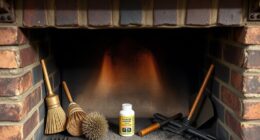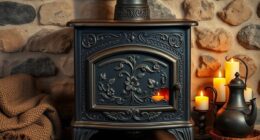I have to admit, lighting up a Traeger wood pellet grill is like sparking a culinary revolution in your own backyard. The popping noises, the enticing flavors, it’s an adventure that will lift you into a realm of barbecue bliss.
In this article, I’m going to show you step by step how to get your Traeger grill up and running. From choosing the perfect wood pellets to adjusting the temperature just right, you’ll have all the knowledge you need to become the grill master of your dreams.
Let’s get fired up!
Key Takeaways
- Choose high-quality wood pellets that align with the desired flavor profile
- Properly store the pellets in an airtight container or tightly sealed bag to maintain their quality
- Thoroughly clean and season the grill before use for even cooking
- Troubleshoot any pellet feed or ignition issues to ensure proper functioning of the grill
Choosing the Right Wood Pellets
To get started, you’ll want to choose the right wood pellets for your Traeger wood pellet grill. When it comes to comparing different types of wood pellets, there are a few things to consider.
First, think about the flavor profile you want to achieve. Different types of wood pellets impart different flavors to your food, such as hickory for a smoky taste or apple for a slightly sweet flavor.
Second, check the quality of the pellets. Look for pellets that are made from 100% hardwood and do not contain fillers or additives.
Finally, consider the size of the pellets, as this can affect the heat and burn time.
Once you have chosen the perfect wood pellets, it is important to store them properly to maintain their quality. Keep the pellets in a dry and cool location, away from moisture and direct sunlight. Moisture can cause the pellets to deteriorate and affect their performance. Use an airtight container or seal the bag tightly to prevent any moisture from getting in. Proper storage will ensure that your wood pellets are ready to use whenever you want to fire up your Traeger grill.
Now that you have chosen the right wood pellets and stored them properly, it’s time to move on to preparing the grill for use.
Preparing the Grill for Use
Before using the grill, make sure it’s properly set up and ready to go.
First, I recommend cleaning the grill thoroughly. Remove any leftover ashes from previous use and wipe down the grates with a grill brush. This will ensure that your food cooks evenly and doesn’t stick to the grates.
Next, it’s important to season the grill. Preheat it to a high temperature and apply a thin coat of cooking oil to the grates. This will create a non-stick surface and prevent rusting.
Once the grill is clean and seasoned, you can move on to filling the pellet hopper. This is where the magic happens, as the wood pellets provide the delicious smoky flavor.
Now that the grill is ready, let’s fill the pellet hopper and start cooking!
Filling the Pellet Hopper
Once the hopper is filled with pellets, you can simply set the temperature and let the grill do the rest of the work. Filling the pellet hopper is an important step in preparing your Traeger wood pellet grill for use. Here are three key things to keep in mind when filling the hopper:
-
Clean the pellet hopper: Before adding new pellets, make sure to clean out any remaining pellets or debris from previous use. This will ensure a clean and efficient burn.
-
Use high-quality pellets: It’s crucial to use high-quality wood pellets specifically designed for pellet grills. Inferior pellets can lead to inconsistent heating and potential feed issues.
-
Troubleshoot pellet feed issues: If you notice any problems with the pellet feed, such as uneven or no pellet flow, check for any blockages in the hopper or auger. Clean out any obstructions and ensure proper alignment of the components.
With the hopper filled and ready, it’s time to ignite the pellet grill and get cooking.
Igniting the Pellet Grill
After cleaning the hopper and filling it with high-quality pellets, you can ignite the grill to begin cooking.
To ensure a successful ignition, it is important to follow some safety precautions. First, make sure the grill is placed on a stable surface away from any flammable materials.
Next, open the pellet hopper lid and turn the grill on. Most pellet grills have an electronic ignition system, so simply press the ignition button and listen for the sound of the igniter. If the igniter doesn’t light up, you may need to troubleshoot common ignition issues such as a clogged igniter or low battery. Always refer to your grill’s manual for specific troubleshooting steps.
Once the grill is ignited, you can move on to adjusting the temperature and smoke levels for your desired cooking experience.
Adjusting the Temperature and Smoke Levels
To achieve your desired cooking experience, you’ll want to adjust the temperature and smoke levels on the pellet grill. Here are some tips for achieving the perfect sear and understanding the different smoke settings:
-
When searing a steak, preheat your grill to a high temperature, around 450°F. This will help create a nice crust on the outside while keeping the inside juicy.
-
For a smokier flavor, use the ‘Smoke’ setting on your pellet grill. This setting allows the grill to produce more smoke, perfect for slow-cooking meats or infusing a smoky flavor into your dishes.
Understanding the different smoke settings:
-
The ‘Smoke’ setting is ideal for low and slow cooking, such as smoking a brisket or ribs.
-
The ‘Medium’ setting is great for a balance of smoke and heat, perfect for cooking chicken or pork chops.
Now that you’ve adjusted the temperature and smoke levels, it’s time to preheat the grill for cooking.
Preheating the Grill for Cooking
Now that you’ve adjusted everything, go ahead and preheat your grill for cooking. Preheating is an important step to ensure optimal cooking results on your Traeger grill. By preheating, you allow the grill to reach the desired temperature, which helps to sear your food and lock in the flavors.
To preheat your Traeger grill, simply turn it on and set the temperature according to your recipe. Give it some time to heat up, usually around 10-15 minutes, depending on the model. During this time, make sure the lid is closed to trap the heat and help the grill reach the desired temperature quickly.
Here are some common mistakes to avoid when preheating your Traeger grill:
| Mistake | Explanation |
|---|---|
| Not preheating long enough | Preheating for the recommended time ensures that the grill is fully heated and ready for cooking. |
| Opening the lid too frequently | Opening the lid releases heat and can significantly increase the preheating time. Avoid unnecessary lid openings. |
| Ignoring temperature fluctuations | It’s normal for the temperature to fluctuate slightly during preheating. Allow the grill to stabilize before placing your food on the grates. |
| Not cleaning the grill beforehand | A clean grill ensures even heat distribution and prevents any unwanted flavors from previous cooks. Take the time to clean your grill before preheating. |
| Neglecting to check for proper airflow | Ensure that the vents on your Traeger grill are open to allow proper airflow, which helps with the preheating process. |
Are the Steps for Starting a Traeger Wood Pellet Grill the Same as Using It for Smoking?
Yes, the steps for starting a Traeger wood pellet grill are the same as using it for smoking. Simply fill the hopper with the desired wood pellets, set the temperature on the control panel, and wait for the grill to reach the set temperature. Then, place the food on the grill and let it smoke to perfection.
Frequently Asked Questions
How Long Does It Take for a Traeger Wood Pellet Grill to Reach the Desired Temperature?
It usually takes about 10-15 minutes for a Traeger wood pellet grill to reach the desired temperature. The heating time may vary depending on factors like outdoor temperature and the amount of pellets used.
Can I Use Regular Charcoal or Gas in a Traeger Wood Pellet Grill?
No, you cannot use regular charcoal or gas in a Traeger wood pellet grill. These grills are designed specifically to use wood pellets as fuel. Using alternative fuel sources can damage the grill and affect the flavor of your food.
How Often Do I Need to Clean the Ash From the Grill?
I find it necessary to clean the ash from my Traeger wood pellet grill on a regular basis to ensure optimal performance. The cleaning frequency depends on how often I use the grill, but I usually do it after every few uses.
Can I Use the Grill in Extreme Weather Conditions, Such as During Heavy Rain or Snow?
Yes, you can use a Traeger Wood Pellet Grill in extreme weather conditions, such as heavy rain or snow. However, it’s important to take necessary precautions to protect the grill from water damage and ensure safe operation.
Are There Any Specific Safety Precautions I Should Take While Using a Traeger Wood Pellet Grill?
When using a Traeger wood pellet grill, it’s important to follow safety precautions. Be sure to keep the grill clean and well-maintained, and always use proper tools and equipment. Regular maintenance will ensure safe and enjoyable grilling experiences.
Conclusion
In conclusion, starting a Traeger wood pellet grill is a simple and rewarding process. By choosing the right wood pellets, preparing the grill, filling the pellet hopper, and igniting the grill, you can be on your way to deliciously smoked and grilled meals.
Some may worry that using a pellet grill is complicated or time-consuming, but fear not! With the step-by-step guide provided, you’ll be a grill master in no time and enjoy the mouthwatering flavors that only a Traeger grill can deliver.
So, go ahead, fire up that grill and let the tantalizing aromas fill the air!

